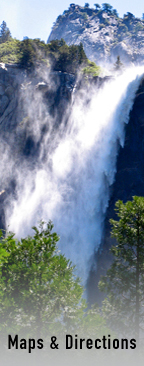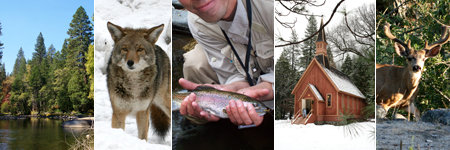

|
The Falls in
Four Seasons Yosemite Falls. No single feature has contributed more to the wide acclaim of Yosemite National Park. The beauty and power of this waterfall—the world’s fifth tallest—are unrivaled in the United States, and its allure spans the globe. No matter what the season, Yosemite Falls inspires all who view it.Just like other components of nature, Yosemite Falls is highly affected by the seasons. The waterfall is at its height in spring and early summer, when melting winter snow collected along the high country path of Yosemite Creek forms a torrent of water that plunges over the cliffs into the Valley. The avalanche of water fills the rock basin with spray and consequent wind. Rainbows appear and disappear, and the thundering sound of the Falls reverberates in the Valley and rattles windows at Yosemite Lodge. By late summer, Yosemite Falls becomes a mere trickle, and often dries up entirely by autumn when the nearby oaks, dogwoods and maple trees are awash in vibrant color.In winter, a completely different phenomenon occurs at Yosemite Falls. “Every clear, frosty morning loud sounds are heard booming and reverberating from side to side of the Valley,” wrote Yosemite’s famous naturalist, John Muir. “The strange thunder is made by the fall of sections of ice formed of spray that is frozen on the face of the cliff along the sides of the Upper Yosemite Fall . . . This frozen spray gives rise to one of the most interesting winter features of the Valley—a cone of ice at the foot of the fall, four or five hundred feet high.” In official records, the maximum height of the cone is documented at 322 feet, about as tall as a 25-story building. When temperatures warm in early spring, the water from the Upper Fall begins to drill a hole at the top of the cone, creating a volcano-like structure, and by mid-April, most of the cone has melted. Another winter occurrence in and around Yosemite Falls is “frazil ice,” a substance that forms in waterfalls and creeks when water becomes super cooled. Turbulence cools the water so that ice crystals form and group into spongy masses, which sometimes overflow the creek bed. In Yosemite Creek, frazil ice has frequently covered trails and damaged bridges, and has even flowed through buildings that once bordered the creek. In 1997, frazil ice was above the railings of the Lower Yosemite Fall bridge, almost completely burying it!Throughout most of the year, the beauty
of Yosemite Falls is no less breathtaking. But the influence of
this waterfall stretches well beyond its immediate impact on viewers.
The grandeur of Yosemite Falls played a primary role in motivating
key individuals to call for the preservation of natural wonders,
rather than exploitation of them. It was this call that led
|

